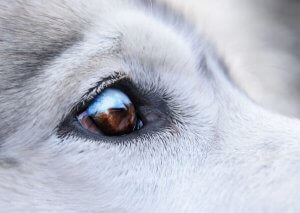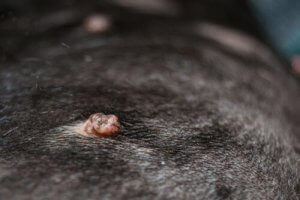Dog Care: Treating Warts Around the Eyes

Warts are benign tumors that grow on the surface of the skin. They can appear on many different parts of the body, including the mouth, muzzle, ears, armpits, abdomen, and genitals. In some cases, you’ll even find warts around the eyes.
And it’s not just dogs, or even just mammals, that can have warts. They can also be found on other animals, including birds.
Warts around the eyes: what causes them?
Warts are usually caused by a type of virus. More specifically, the papilloma virus specific to that particular species. In dogs, we’re dealing with papiloma canino. This means that warts aren’t contagious between different species, so you can’t catch them from your pet.
This virus can affect dogs of any age, although it’s more common in older dogs, and those with compromised immune systems.

Causes of warts in dogs
Papiloma canino is spread when an animal comes into direct contact with the virus. It’s usually spread orally. For example, your dog could catch it by drinking from infected water, or by sharing toys with an infected dog.
But coming into contact with the virus doesn’t necessarily mean your dog will develop warts. It’ll all depend on the strength of its immune system. The incubation period can be a long one, varying from one to two months.
Warts usually affect puppies, older dogs, and animals that are immuno-depressed, such as those suffering from cancer, an infection, or congenital immunodeficiency, which is common in certain breeds.
Some types of warts aren’t actually caused by a virus, such as sebaceous adenoma, which appears as a result of a problem in the sebaceous glands. These are more common in older dogs, and you normally find them on the eyelids or paws.
What do warts look like?
Warts are typically round in shape, with an irregular surface that looks a bit like the top of a cauliflower. They’re easily noticeable once they reach a certain size, particularly those around the eyes and mouth.
Generally speaking, warts aren’t painful, but they can sometimes appear in inconvenient places, causing discomfort for your pet. They don’t normally bleed either, unless your dog licks or scratches them frequently.

How to treat warts around the eyes
Warts usually stop growing after reaching a certain size. They aren’t normally a cause for concern, and typically dry out and disappear over time. In most cases, the presence of warts doesn’t have any negative side effects for the animal, so it isn’t generally something that requires veterinary treatment.
However, if you notice any discoloration, or changes in the size or shape of the warts, the best thing to do is take your pet for a check-up. Cancerous tumors often appear in the form of warts, so it’s important for your vet to rule this out.
This usually means taking a tissue sample. Using a needle, the vet will take a small amount of fluid from inside the wart, and examine the cells under a microscope.
Surgery and cryotherapy
If the wart is preventing the animal from seeing, eating or walking normally, or if it licks or chews the wart constantly, causing it to bleed, or the vet suspects it may be a sign of cancer, then it may be best to remove the growths. This should always be done by a professional at the vet clinic.
The vet may perform minor surgery to remove the wart, or use cryotherapy to freeze the lump until it disappears.
The dog may also require medication to boost its immune system and combat the underlying virus.
Never try to remove the warts yourself. Don’t attempt to use home remedies or products designed for humans on your pet, especially if the warts are close to the eyes. You could cause skin lesions, damage their eyesight, or even penetrate the eye.
If you notice warts on your pet’s skin, the best thing to do is consult with your vet. In most cases, there’s really nothing to worry about.
Warts are benign tumors that grow on the surface of the skin. They can appear on many different parts of the body, including the mouth, muzzle, ears, armpits, abdomen, and genitals. In some cases, you’ll even find warts around the eyes.
And it’s not just dogs, or even just mammals, that can have warts. They can also be found on other animals, including birds.
Warts around the eyes: what causes them?
Warts are usually caused by a type of virus. More specifically, the papilloma virus specific to that particular species. In dogs, we’re dealing with papiloma canino. This means that warts aren’t contagious between different species, so you can’t catch them from your pet.
This virus can affect dogs of any age, although it’s more common in older dogs, and those with compromised immune systems.

Causes of warts in dogs
Papiloma canino is spread when an animal comes into direct contact with the virus. It’s usually spread orally. For example, your dog could catch it by drinking from infected water, or by sharing toys with an infected dog.
But coming into contact with the virus doesn’t necessarily mean your dog will develop warts. It’ll all depend on the strength of its immune system. The incubation period can be a long one, varying from one to two months.
Warts usually affect puppies, older dogs, and animals that are immuno-depressed, such as those suffering from cancer, an infection, or congenital immunodeficiency, which is common in certain breeds.
Some types of warts aren’t actually caused by a virus, such as sebaceous adenoma, which appears as a result of a problem in the sebaceous glands. These are more common in older dogs, and you normally find them on the eyelids or paws.
What do warts look like?
Warts are typically round in shape, with an irregular surface that looks a bit like the top of a cauliflower. They’re easily noticeable once they reach a certain size, particularly those around the eyes and mouth.
Generally speaking, warts aren’t painful, but they can sometimes appear in inconvenient places, causing discomfort for your pet. They don’t normally bleed either, unless your dog licks or scratches them frequently.

How to treat warts around the eyes
Warts usually stop growing after reaching a certain size. They aren’t normally a cause for concern, and typically dry out and disappear over time. In most cases, the presence of warts doesn’t have any negative side effects for the animal, so it isn’t generally something that requires veterinary treatment.
However, if you notice any discoloration, or changes in the size or shape of the warts, the best thing to do is take your pet for a check-up. Cancerous tumors often appear in the form of warts, so it’s important for your vet to rule this out.
This usually means taking a tissue sample. Using a needle, the vet will take a small amount of fluid from inside the wart, and examine the cells under a microscope.
Surgery and cryotherapy
If the wart is preventing the animal from seeing, eating or walking normally, or if it licks or chews the wart constantly, causing it to bleed, or the vet suspects it may be a sign of cancer, then it may be best to remove the growths. This should always be done by a professional at the vet clinic.
The vet may perform minor surgery to remove the wart, or use cryotherapy to freeze the lump until it disappears.
The dog may also require medication to boost its immune system and combat the underlying virus.
Never try to remove the warts yourself. Don’t attempt to use home remedies or products designed for humans on your pet, especially if the warts are close to the eyes. You could cause skin lesions, damage their eyesight, or even penetrate the eye.
If you notice warts on your pet’s skin, the best thing to do is consult with your vet. In most cases, there’s really nothing to worry about.
All cited sources were thoroughly reviewed by our team to ensure their quality, reliability, currency, and validity. The bibliography of this article was considered reliable and of academic or scientific accuracy.
- Lange, C., Zollinger, S., Tobler, K., Ackermann, M. y Favrot, C. Clinically Healthy Skin of Dogs Is a Potential Reservoir for Canine Papillomaviruses. J. Clin. Microbiol. 49: 707.
- Diagnósticoveterinario.com
- Toppercan
This text is provided for informational purposes only and does not replace consultation with a professional. If in doubt, consult your specialist.








